AOC E1659FWU And GeChic On-Lap 1502I: Portable Monitors, To Go
AOC and GeChic recently introduced a pair of portable, USB-powered displays. GeChic’s On-Lap 1502I boasts a 1920x1080 resolution and 10-point multi-touch. AOC’s E1659FWU delivers simplicity and a low price. We compare their display performance today.
Results: Grayscale Tracking And Gamma Response
A majority of monitors, especially newer models, display excellent grayscale tracking (even at stock settings). It’s important that the color of white be consistently neutral at all light levels from darkest to brightest. Grayscale performance impacts color accuracy with regard to the secondary colors: cyan, magenta, and yellow. Since computer monitors typically have no color or tint adjustment, accurate grayscale is key.
Because AOC's E1659FWU has no calibration controls, we can only show you a single grayscale result.
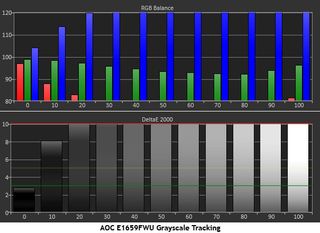
The color temp is very cool, with an obvious blue tint to the image. The advantage of this is that the panel look a little brighter than its luminance numbers would suggest. Our main complaint is that you can’t match the color temp of the E1659FWU to your main monitor. Since its main use is as a secondary screen, there should be a way to synchronize its color settings. Even a couple of presets would be an improvement.
Here is the GeChic’s out-of-box measurement.
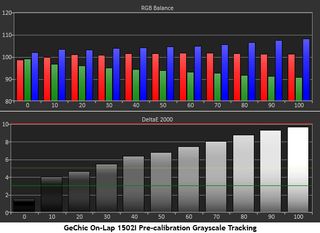
This result shows the user color temp preset with no changes made to the RGB sliders. There is a slight blue tint to the image that increases with brightness. This is the best mode to use if you don’t calibrate. The warm preset adds a noticeable red tint, and makes the image look a bit flat.
Now, here's the calibrated result.
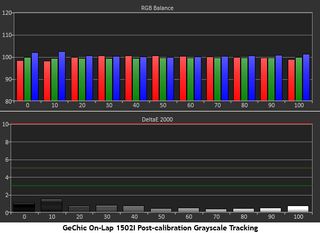
This is one of the best grayscale charts we’ve seen. The Delta E error is under one at all brightness levels except for 10 percent, where it is still comfortably under two. We're pleasantly surprised by such an excellent performance.
Stay on the Cutting Edge
Join the experts who read Tom's Hardware for the inside track on enthusiast PC tech news — and have for over 25 years. We'll send breaking news and in-depth reviews of CPUs, GPUs, AI, maker hardware and more straight to your inbox.
Let’s bring our comparison group back into the mix.
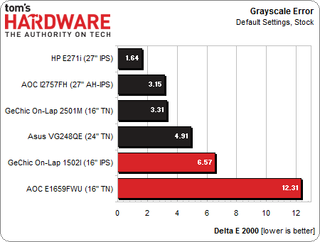
Neither portable does particularly well by default, and the On-Lap 1502I demonstrates more grayscale error than its predecessor, the On-Lap 2501M. AOC’s E1659FWU has errors ranging from a low of 2.78 to a high of 15.71 Delta E.
GeChic's submission can be calibrated to a high standard at least, while AOC’s portable must make do with no adjustment.

The On-Lap 1502I even bests a number of desktop screens in our comparison group. Its IPS glass offers excellent grayscale performance. And a wide range of adjustment means you can match the color temp to any desktop monitor you use it with. If you go with AOC's more affordable option, we recommend using a product like CalMAN or Spyder to generate a LUT so your screens display the same color temp.
Gamma Response
Gamma is the measurement of luminance levels at every step in the brightness range from 0 to 100 percent. This is important because poor gamma can either crush detail at various points or wash it out, making the entire picture appear flat and dull. Correct gamma produces a more three-dimensional image, with a greater sense of depth and realism. Meanwhile, incorrect gamma can negatively affect image quality, even in monitors with high contrast ratios.
In the gamma charts below, the yellow line represents 2.2, which is the most widely accepted standard for television, film, and computer graphics production. The closer the white measurement trace comes to 2.2, the better.
We begin with the E1659FWU’s graph.

AOC's E1659FWU redeems itself with a decent gamma measurement. Tracking is fairly flat from 10 percent brightness on up. And the values stick pretty close to 2.2. A dip at 10 percent represents a brightness level that’s 1.7 cd/m2 too high.
The On-Lap 1502I’s chart looks even better.
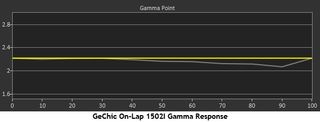
GeChic's gamma response is just as good as its grayscale accuracy. Tracking is almost ruler-flat, with just the tiniest dip at 90 percent brightness. This helps increase perceived contrast quite a bit.
Here’s our test group again for the gamma comparisons.

GeChic's 1502I and the 2502M display the best gamma response among our portable contenders. A range of .14 places the company's newest product among the best displays we’ve reviewed. AOC isn’t far behind with a .39 variation.
We calculate the average gamma deviation by simply expressing the difference from 2.2 as a percentage.

None of the portable monitors we’ve reviewed stray too far from the 2.2 gamma standard. This helps improve perceived contrast, which is a good thing considering the middling native contrast performance we already measured.
Current page: Results: Grayscale Tracking And Gamma Response
Prev Page Results: Brightness And Contrast Next Page Results: Color Gamut And Performance
Christian Eberle is a Contributing Editor for Tom's Hardware US. He's a veteran reviewer of A/V equipment, specializing in monitors. Christian began his obsession with tech when he built his first PC in 1991, a 286 running DOS 3.0 at a blazing 12MHz. In 2006, he undertook training from the Imaging Science Foundation in video calibration and testing and thus started a passion for precise imaging that persists to this day. He is also a professional musician with a degree from the New England Conservatory as a classical bassoonist which he used to good effect as a performer with the West Point Army Band from 1987 to 2013. He enjoys watching movies and listening to high-end audio in his custom-built home theater and can be seen riding trails near his home on a race-ready ICE VTX recumbent trike. Christian enjoys the endless summer in Florida where he lives with his wife and Chihuahua and plays with orchestras around the state.
-
g-unit1111 Interesting, I'm interested in getting one of the USB displays but the resolution is keeping me from purchasing one. I'd like to see how the AOC monitor compares to the ones being offered from Asus, HP, Dell, and so on and so forth.Reply -
mathew7 So....I am looking for a few years for a small (15" would be limit) portable VGA+HDMI monitor (as in not a bulky stand). I don't need FullHD resolution, but it should accept it.Reply
In a related note, I have been thinking about a laptop-styled monitor+keyboard (and maybe mouse/touchpad) but to be plugged into a desktop PC. You know...when you receive a PC case (or go to someone) and have to debug it. But again, 15" is already big (I'm using a 12.5" thinkpad when not at my gaming/workstation PC). -
ceberle You can connect the On-Lap to a phone or tablet via its HDMI/MHL port. The AOC will only work via USB.Reply
-Christian- -
CrisCrossed Two words:Reply
Able HD
http://www.able-hd.com
One of the most funded projects on kickstarter. These guys make portable monitors that are HD and really cheap. Unfortunately, they still have their flaws (the circuit board is exposed and not attached to the screen) but you cannot beat the price/performance. -
g-unit1111 Reply12343796 said:Two words:
Able HD
http://www.able-hd.com
One of the most funded projects on kickstarter. These guys make portable monitors that are HD and really cheap. Unfortunately, they still have their flaws (the circuit board is exposed and not attached to the screen) but you cannot beat the price/performance.
I have to say after reading about these that I do want one. When my laptop's primary display is 1920 x 1080, why would I want to add a second monitor that's 1366 x 720? -
CrisCrossed ReplyI have to say after reading about these that I do want one. When my laptop's primary display is 1920 x 1080, why would I want to add a second monitor that's 1366 x 720?
I'm sorry, I mistyped. The monitor is actually a FHD (1080p) display, and it comes in 15.6 and 17 inch screens. I hope this helps. I'm ordering mine soon to use with a LAN box.
Most Popular

